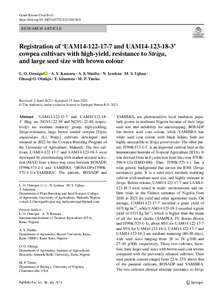| dc.contributor.author | Omoigui, L. |
| dc.contributor.author | Kamara, A. |
| dc.contributor.author | Shaibu, A.S. |
| dc.contributor.author | Iyorkaa, N. |
| dc.contributor.author | Ugbaa, M.S. |
| dc.contributor.author | Olufajo, O. |
| dc.contributor.author | Iolarmen, T. |
| dc.contributor.author | Timko, M.P. |
| dc.date.accessioned | 2023-09-08T10:50:53Z |
| dc.date.available | 2023-09-08T10:50:53Z |
| dc.date.issued | 2023-07-06 |
| dc.identifier.citation | Omoigui, L., Kamara, A., Shaibu, A.S., Iyorkaa, N., Ugbaa, M.S., Olufajo, O., ... & Timko, M.P. (2023). Registration of ‘UAM14-122-17-7 and UAM14-123-18-3’cowpea cultivars with high-yield, resistance to Striga, and large seed size with brown colour. Genetic Resources and Crop Evolution, 1-15. |
| dc.identifier.issn | 0925-9864 |
| dc.identifier.uri | https://hdl.handle.net/20.500.12478/8247 |
| dc.description.abstract | ‘UAM14-122-17-7 and UAM14-123-18-3’ (Reg. no. NGVU-22-39 and NGVU-22-40, respectively) are medium maturity group, high-yielding, Striga-resistance, large brown seeded cowpea [Vigna unguiculata (L) Walp.] cultivars developed and released in 2022 by the Cowpea Breeding Program of the University of Agriculture, Makurdi. The two cultivars UAM14-122-17-7 and UAM14-123-18-3 were developed by crossbreeding with marker-assisted selection (MAS) from a three-way cross between BOSADP, IT99K-573-1-1 and YAMISRA ‘(BOSADP × IT99K-573-1-1) × YAMISRA’. The parents, BOSADP and YAMISRA, are photosensitive local landraces popularly grown in northeast Nigeria because of their large seed size and suitability for intercropping. BOSADP has brown seed coat colour, while YAMISRA has white seed coat colour with black hilum; both are highly susceptible to Striga gesnerioides. The other parent, IT99K-573-1-1’ is an improved cultivar bred at the International Institute of Tropical Agriculture (IITA). It was derived from an F5 selection from the cross IT93K-596-9-12 × IT86D-880. Thus, IT99K-573-1-1 has a wide genetic background that carries the B301 (Striga resistance) gene. It is a semi-erect medium maturing cultivar with medium seed size, and highly resistant to Striga. Before release, UAM14-122-17-7 and UAM14-123-18-3 were tested in multi- environments and on-farm trials in the Guinea savannas of Nigeria from 2018 to 2021 for yield and other agronomic traits. On average, UAM14-122-17-7 recorded a grain yield of 1671 kg ha−1, while UAM14-123-18-3 recorded a grain yield of 1511 kg ha−1, which is higher than the mean of all the local checks (SAMPEA 19, Borno Brown and IT99K-573-1-1), about 80% for UAM14-122-17-7 and 95% for UAM14-123-18-3. UAM14-122-17-7 and UAM14-123-18-3 are medium maturing (80–85 days), with seed sizes ranging from 26 to 28 g/100 and 27–30 g/100, respectively. These two cultivars, therefore, have larger seed sizes with brown seed coat texture compared with the previously released cultivars. Their seed protein content ranged from 22 to 25% above that of the parental cultivars, BOSADP and YAMISRA. The two cultivars showed absolute resistance to Striga gesnerioides race 3 (SG3) prevalent in Nigeria and good adaptation for intercropping with cereals. The two cultivars were approved for release and registered in the Nigeria Variety Catalogue of the Plant Varieties in 2022 based on their superior performance in on-station, field and multi-locational trials and the massive demand for high-yielding Striga-resistant cowpea cultivars with brown seed coat colour and large seed by farmers. The National Variety Release Committee formally released the two cultivars UAM14-122-17-7 and UAM14-123-18-3 in 2022. It gave it the national code name FUAMPEA 3 and FUAMPEA 4, respectively, for cultivation in Nigeria (NCGRB 2023). The availability of these cultivars to farmers would increase cowpea production and productivhity under variable cropping systems. |
| dc.description.sponsorship | Kirkhouse Trust UK |
| dc.format.extent | 1-15 |
| dc.language.iso | en |
| dc.subject | Cowpeas |
| dc.subject | Cultivars |
| dc.subject | Striga |
| dc.subject | Yields |
| dc.subject | Nigeria |
| dc.title | Registration of ‘UAM14‑122‑17‑7 and UAM14‑123‑18‑3’ cowpea cultivars with high‑yield, resistance to Striga, and large seed size with brown colour |
| dc.type | Journal Article |
| cg.contributor.crp | Grain Legumes |
| cg.contributor.crp | Maize |
| cg.contributor.affiliation | International Institute of Tropical Agriculture |
| cg.contributor.affiliation | Bayero University Kano |
| cg.contributor.affiliation | Ahmadu Bello University |
| cg.contributor.affiliation | University of Agriculture Makurdi |
| cg.contributor.affiliation | University of Virginia |
| cg.coverage.region | Africa |
| cg.coverage.region | West Africa |
| cg.coverage.country | Nigeria |
| cg.coverage.hub | Headquarters and Western Africa Hub |
| cg.researchtheme | Biotech and Plant Breeding |
| cg.researchtheme | Plant Production and Health |
| cg.identifier.bibtexciteid | OMOIGUI:2023b |
| cg.isijournal | ISI Journal |
| cg.authorship.types | CGIAR and developing country institute |
| cg.iitasubject | Agronomy |
| cg.iitasubject | Cowpea |
| cg.iitasubject | Food Security |
| cg.iitasubject | Grain Legumes |
| cg.iitasubject | Plant Breeding |
| cg.iitasubject | Plant Production |
| cg.journal | Genetic Resources and Crop Evolution |
| cg.notes | Published online: 06 Jul 2023 |
| cg.accessibilitystatus | Limited Access |
| cg.reviewstatus | Peer Review |
| cg.usagerightslicense | Copyrighted; all rights reserved |
| cg.targetaudience | Scientists |
| cg.identifier.doi | https://doi.org/10.1007/s10722-023-01638-0 |
| cg.iitaauthor.identifier | Lucky Omoigui: 0000-0001-8473-2775 |
| cg.iitaauthor.identifier | Alpha Kamara: 0000-0002-1844-2574 |
| cg.futureupdate.required | No |

